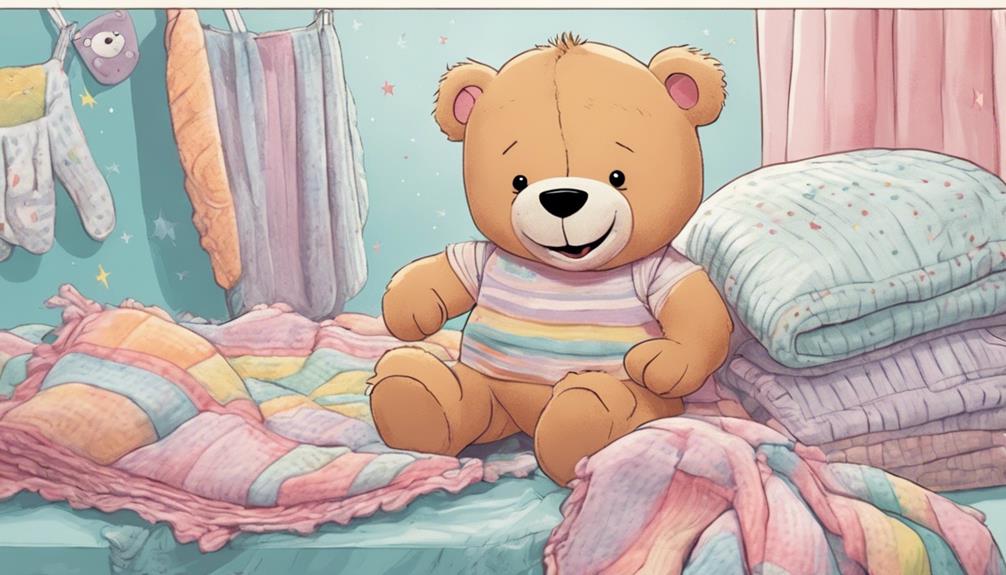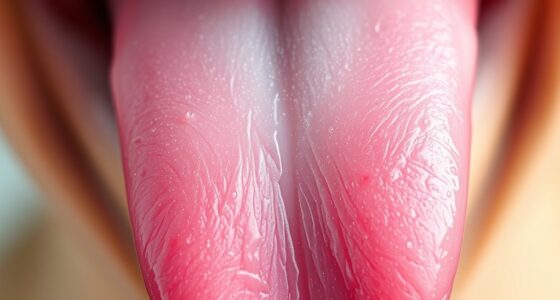Babies usually start teething around six months, with the first teeth being the lower central incisors. By the time they turn three, they'll have a complete set of 20 primary teeth. You might notice signs like swollen gums, increased drooling, or fussiness as teeth break through. To help soothe discomfort, you can use chilled teething rings or gently massage their gums. It's also a good idea to clean their gums before teeth appear and schedule their first dental visit by their first birthday. To learn more about teething and dental care, keep exploring the topic!
Key Takeaways
- Babies typically start teething between 4 to 7 months, with the first tooth often being the lower central incisors.
- The complete set of 20 primary teeth usually emerges by the age of 3.
- The order of tooth eruption generally follows: lower central incisors, upper central incisors, lateral incisors, first molars, canines, and second molars.
- Common signs of teething include increased drooling, swollen gums, irritability, and changes in sleeping patterns.
Understanding Teething

Teething is a natural process that usually starts when your baby is around 4 to 7 months old, though some may begin as early as 3 months. During this time, you'll notice that babies start teething, and the first tooth to emerge is typically the lower central incisors. This can lead to signs of discomfort, such as sore gums and increased drooling.
As your baby goes through teething, they might exhibit various teething symptoms, including irritability and difficulty sleeping. Not every baby shows clear signs of discomfort, so it's important to keep an eye on their behavior.
To help soothe sore gums, you can use teething rings, especially those that are chilled for added relief. Safe teething remedies can make the process more manageable for both you and your baby. Massaging your baby's gums gently can also provide comfort.
While it's tempting to reach for over-the-counter products, be cautious and avoid teething gels with benzocaine due to safety concerns. Remember, maintaining good oral health during this stage is vital, as it sets the foundation for your child's dental well-being in the future.
Teething Timeline
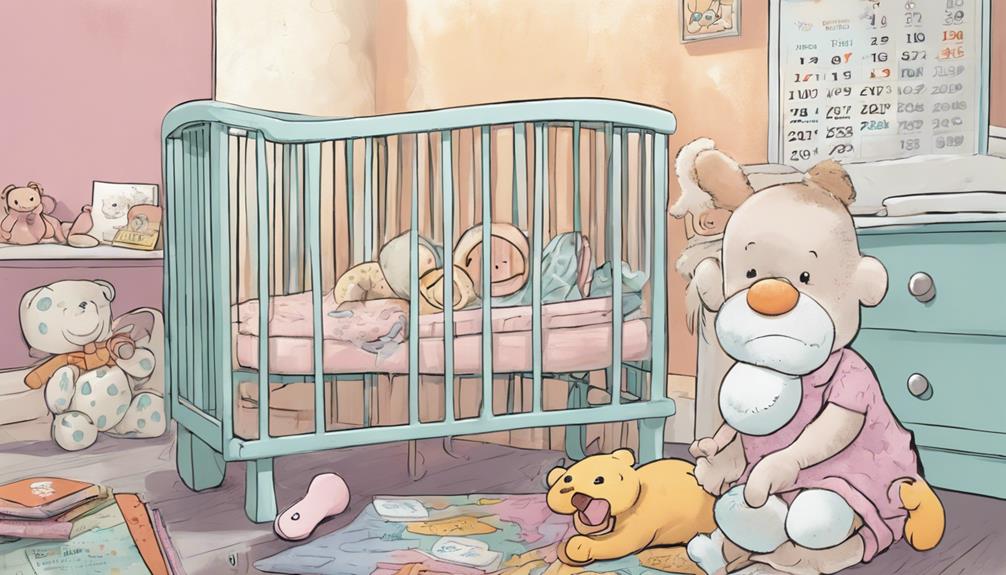
When your baby starts teething, it usually kicks off between 4 to 12 months, with most infants getting their first tooth around 6 months.
You'll likely notice those lower central incisors coming in first, followed by the upper ones.
Understanding this typical eruption schedule can help you spot the signs of teething as they happen.
Typical Eruption Schedule
Babies usually start getting their first teeth between 4 and 7 months of age. The teething process can vary, and it's important to know what to expect during this critical time for your little one.
Here's a typical eruption schedule for primary teeth:
- 4 to 7 months: First tooth usually appears
- 6 to 10 months: Lower central incisors erupt
- 8 to 12 months: Upper central incisors come in
- 9 to 16 months: Lateral incisors emerge
The complete sequence generally follows the order of central incisors, lateral incisors, first molars, canines, and second molars. By age 3, your baby should have all 20 primary teeth, which play a crucial role in chewing and speech development.
The eruption of teeth can cause discomfort, so understanding the timeline can help you support your baby through teething. Keep an eye on those gums, as they may be sensitive when those new teeth start to break through!
Signs of Teething
Recognizing the signs of teething can help you support your little one through this uncomfortable phase. Teething typically begins around 4 to 7 months, and you might notice increased drooling, irritability, and swollen gums as those first teeth start to push through. Your baby may seem fussier than usual, and you might even detect a slight elevation in their temperature.
However, keep an eye out—if they've a high fever or diarrhea, it's best to consult a pediatrician, as these aren't common teething symptoms.
As tooth eruption progresses, you may want to try teething gels or teething necklaces to ease your little one's discomfort. These can provide relief from teething pain while keeping them occupied.
The first teeth usually emerge in a specific order, beginning with the lower central incisors. By being aware of these signs, you can better prepare for this milestone, ensuring your baby feels supported during this changeable period.
Recognizing Teething Symptoms
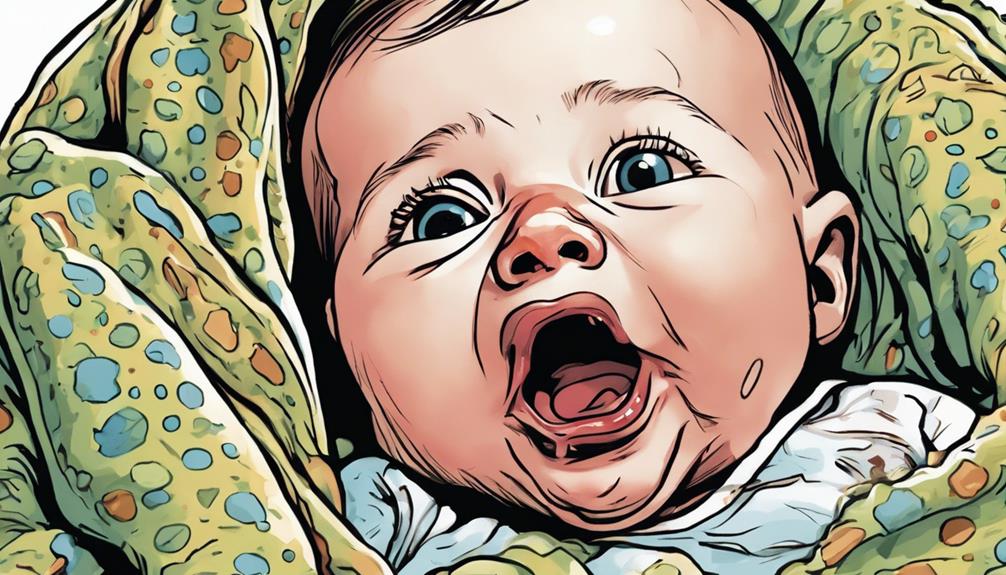
When your baby starts teething, you might notice some common indicators that signal discomfort.
Increased drooling, irritability, and swollen gums are just a few signs to watch for.
Recognizing these symptoms can help you find effective soothing techniques to ease your little one's pain.
Common Teething Indicators
Teething often brings noticeable changes in your baby's behavior, so it's important to watch for common symptoms like increased drooling and gum discomfort. Recognizing these teething symptoms can help you understand what your little one is going through.
Here are some key indicators to look for:
- Increased drooling
- Swollen and tender gums
- Strong desire to chew on objects
- Irritability and fussiness
You might notice that your baby shows irritability due to gum discomfort, although some infants may not experience any pain at all. Keep an eye out for swollen gums, as they're a frequent sign of teething.
A slight temperature elevation is also common, but if your baby develops a high fever, it could indicate another health issue requiring medical attention.
You may observe changes in your baby's sleeping patterns and a decreased appetite during this time.
Soothing Techniques for Discomfort
To help ease your baby's discomfort during teething, consider trying a few effective soothing techniques that can provide relief.
Common teething symptoms include increased drooling, irritability, and swollen gums, which can make your little one fussy. Gently massaging your baby's gums with a clean finger can soothe the pain, or you can offer chilled teething rings—just avoid those filled with liquid, as they may leak.
Cold washcloths are another excellent option. Simply dampen a clean washcloth, chill it in the refrigerator, and let your baby chew on it. This can provide soothing relief from sore gums.
While some parents may consider over-the-counter pain relief, remember to consult your pediatrician first and avoid teething gels containing benzocaine for infants under 2 years.
Creating a calming environment can also help manage teething irritability. Provide comfort items and distractions to keep your baby engaged.
Managing Teething Discomfort
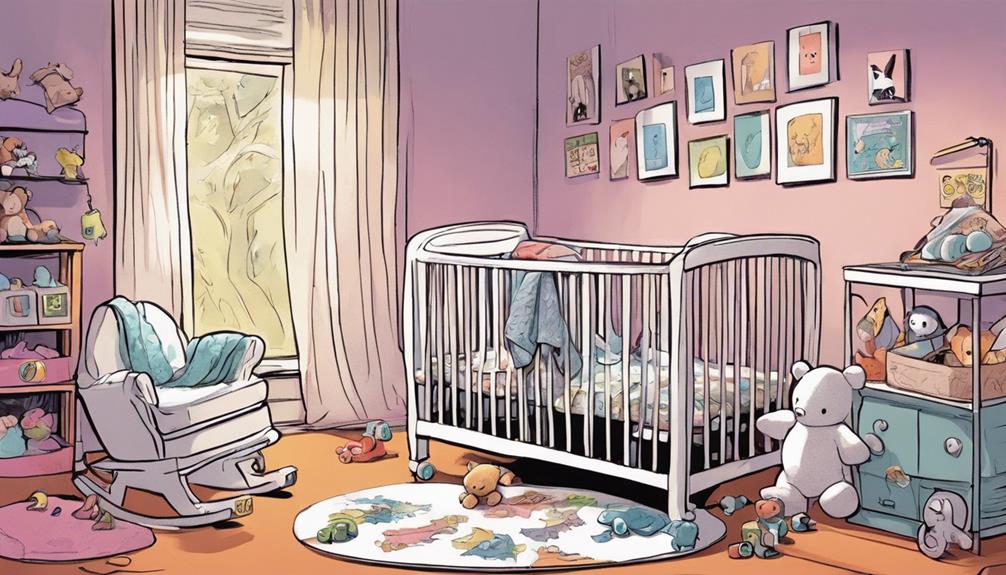
Managing teething discomfort involves finding effective ways to soothe your baby's sore gums and keep them comfortable during this challenging phase. Here are some helpful strategies:
- Use cold teething rings to numb the gums.
- Freeze a washcloth for your baby to chew on.
- Gently massage your baby's gums with clean fingers.
- Consult your pediatrician about safe pain relief options.
Teething can cause mild discomfort in babies, leading to symptoms like drooling, swollen gums, and irritability as teeth push through.
Cold teething rings or frozen washcloths can provide soothing relief, while gentle gum massage may also help alleviate discomfort.
If you notice a slight temperature rise, it's usually normal, but any high fever or other concerning symptoms should prompt a consultation with a healthcare provider.
Remember, maintaining proper oral hygiene from the eruption of the first tooth is essential, as it establishes healthy habits and can reduce future teething discomfort.
Dental Care for Infants

Once your baby's first tooth appears, it's important to start a dental care routine to promote healthy oral hygiene from an early age.
Begin by gently cleaning your infant's gums with a soft cloth before the first tooth erupts. This establishes good habits and prepares them for brushing. Once that first tooth comes in, brush it twice daily using a soft-bristled toothbrush and a smear of fluoride toothpaste. This helps prevent cavities and supports dental health as they grow.
By the time your child turns one or after their first tooth appears, schedule their first dental visit. This early check-up will help monitor their dental health and development.
As your child gets older, teach them to spit out excess toothpaste, usually around ages 2 or 3, to avoid swallowing too much fluoride.
Regular dental check-ups and maintaining a consistent oral hygiene routine are essential for preventing cavities and ensuring your child's ongoing dental health.
With these practices in place, you're setting your little one on the path to a lifetime of healthy smiles!
First Dental Visit

Your child's first dental visit is a crucial step in ensuring their oral health and establishing a positive relationship with dental care. This visit usually happens by age 1 or within six months after their first tooth emerges.
Here's what you can expect:
- Monitoring your child's dental development
- Addressing signs of decay early
- Learning about effective oral hygiene practices
- Getting advice on teething and dental care routines
Pediatric dentists specialize in young children's needs, focusing on both preventive and educational aspects of oral health.
During the first dental visit, the dentist will check for proper alignment and any signs of decay while discussing your child's medical history and any specific concerns you might have.
This proactive approach not only promotes good oral hygiene practices but also helps your child feel comfortable in a dental setting.
Frequently Asked Questions
In What Order Do Babies Get Teeth?
Babies typically get their teeth in a specific order: first, lower central incisors; then upper central incisors; followed by upper lateral incisors, lower lateral incisors, first molars, canines, and second molars as they grow.
How Many Teeth Should a 1 Year Old Have?
Wondering how many teeth your one-year-old should have? By their first birthday, most babies have between 1 to 8 teeth, with about 4 being typical if they're following a normal teething timeline.
What Way Do Babies Teeth Come Through?
When babies teeth come through, they usually start with the lower central incisors, followed by upper central incisors. You might notice gum swelling and increased drooling during this process, which is completely normal.
How Do Babies Teeth Break Through?
As tiny flowers push through the earth, babies' teeth emerge, breaking through gums with pressure and swelling. You'll notice signs like drooling and chewing, marking this natural journey from hidden buds to shining smiles.
At What Age Do Babies Typically Get Their First Teeth?
Babies typically get their first teeth around 6-10 months of age. This is when the process of how teeth emerge in babies begins. The lower front teeth, known as the central incisors, usually come in first, followed by the upper front teeth. It’s a developmental milestone for their growing bodies.
Conclusion
To sum up, teething can be a challenging time for both you and your baby, but it's a natural part of their development. It’s important to be understanding and patient with your little one during this process, as they may be experiencing discomfort and crankiness. Remember to provide them with soothing teething toys or cold washcloths to help alleviate their discomfort. Additionally, regular dental check-ups are essential for monitoring your baby’s baby teeth development and ensuring that everything is progressing as it should be.
Did you know that most kids have a full set of 20 primary teeth by age three?
Staying informed about the teething timeline and symptoms can help you manage any discomfort your little one might feel.
Remember to prioritize dental care early on, setting the stage for a lifetime of healthy smiles!



